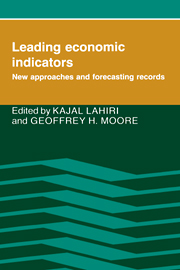Book contents
- Frontmatter
- Contents
- Preface
- List of contributors
- 1 Introduction
- PART I NEW CONCEPTS AND METHODS
- PART II FORECASTING RECORDS AND METHODS OF EVALUATION
- 9 Forecasting cyclical turning points: The record in the past three recessions
- 10 Turning point predictions, errors, and forecasting procedures
- 11 Forecasting peaks and troughs in the business cycle: On the choice and use of appropriate leading indicator series
- 12 Using a consensus of leading economic indicators to find the right ball park for real GNP forecasts
- 13 Some Australian experience with leading economic indicators
- 14 Turning point prediction with the composite leading index: An ex ante analysis
- 15 Forecasting recessions under the Gramm-Rudman-Hollings law
- 16 Leading indicators of inflation
- PART III NEW ECONOMIC INDICATORS
- Index
16 - Leading indicators of inflation
Published online by Cambridge University Press: 05 June 2012
- Frontmatter
- Contents
- Preface
- List of contributors
- 1 Introduction
- PART I NEW CONCEPTS AND METHODS
- PART II FORECASTING RECORDS AND METHODS OF EVALUATION
- 9 Forecasting cyclical turning points: The record in the past three recessions
- 10 Turning point predictions, errors, and forecasting procedures
- 11 Forecasting peaks and troughs in the business cycle: On the choice and use of appropriate leading indicator series
- 12 Using a consensus of leading economic indicators to find the right ball park for real GNP forecasts
- 13 Some Australian experience with leading economic indicators
- 14 Turning point prediction with the composite leading index: An ex ante analysis
- 15 Forecasting recessions under the Gramm-Rudman-Hollings law
- 16 Leading indicators of inflation
- PART III NEW ECONOMIC INDICATORS
- Index
Summary
Sharp increases in both the average level and the variability of inflation in the 1970s focused the attention of economists on the inflationary process. Outside the mainstream of academic research, a number of economists have proposed leading indicators of inflation. These indicators, it is hoped, will warn of impending significant changes in the rate of inflation. An underlying assumption is that inflation, like economic output, is cyclical, with peaks and troughs in the rate of inflation defining inflation cycles. The inflation indicators are designed to “predict” as accurately as possible past peaks and troughs in inflation. Thus, the development of leading indicators of inflation extends the indicator approach long associated with business cycle research to inflation forecasting.
This chapter evaluates five leading indicators of inflation. Three are composite indexes that use the methodology employed by the Department of Commerce in computing the composite indexes for the business cycle. Another is the growth rate of M1. The fifth is based on the ratio of capacity utilization to the foreign exchange value of the dollar. In general, the indicators show promise, but it is too early to embrace them wholeheartedly. The indicators are new, and while they “predict” past turning points in inflation quite well, there is no guarantee that they can warn of future turning points in inflation – the task for which they were developed.
This chapter is structured as follows. Section 16.1 describes the five leading indicators of inflation, section 16.2 assesses how useful the indicators may be in predicting inflation, and section 16.3 summarizes the study.
- Type
- Chapter
- Information
- Leading Economic IndicatorsNew Approaches and Forecasting Records, pp. 275 - 302Publisher: Cambridge University PressPrint publication year: 1991
- 6
- Cited by



